- Henna hair dyeing technique at home
- How to dilute and prepare henna for coloring?
- Recipes for dyeing hair with henna - what components to add when brewing it
- Henna hair coloring tips and tricks
- How to wash off henna?
- Henna-dyed hair care
- The result of henna staining: photo BEFORE and AFTER
- Dyeing for dark hair
- Hair dyeing
- Henna dyeing for blond hair
- What does henna consist of?
- Types of henna for hair
- Iranian
- Sudanese
- Indian
- Colorless
- White
- How to achieve the desired shade?
- We select the color
- Henna and Basma
- Ginger
- Red
- Chestnut
- In brown
- Blond
- Golden
- Chocolate
- 10 important things to consider when dyeing henna
- 1. Make sure the henna you are using is natural
- 2. Henna is not washed off. Never at all.
- 3. Henna can be muted.
- 4. Henna cannot be combined with chemical paints. Neither before nor after staining.
- 5. The result of dyeing with henna will be predictable and of high quality only if you dye natural hair.
- 6. The lighter your own hair, the brighter the result will be.
- Therefore, it is better not for natural blondes to use natural henna. To strengthen hair without dyeing, there is the so-called "colorless henna".
- 8. Dilute henna in a non-metallic container.
- 9. Apply henna only to clean hair.
- 10. You should know the properties that the hair will acquire after dyeing with henna.
- How to remove henna from hair
- Oil mask
- Alcohol mask
- Sour cream.
- Soap.
- Kefir and yeast.
- Vinegar.
- The benefits of henna for hair
- Potential harm
- Using colorless henna
Henna hair dyeing technique at home
Before dyeing curls with henna at home, you need to prepare basic set of tools:
- gloves and a cape to protect skin and clothing;
- plastic cap or bag, cling film;
- comb with sparse teeth;
- clips or hairpins;
- paint brush;
- petroleum jelly or fat cream;
- non-metallic utensils for the preparation of the coloring composition;
- stirring stick;
- unnecessary towel.
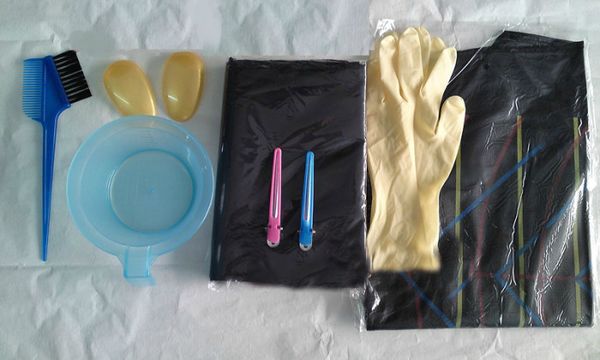
The essence of painting consists in the following actions:
- The powder should be diluted according to the instructions.
- The hairline must be lubricated with a fat cream or petroleum jelly. This will help prevent staining of the skin, henna in such cases is extremely difficult to wash off.
- Divide the curls into 4 zones: temporal, occipital and crown.
- Separate several strands from each zone, carefully paint over them with a brush.
- Pin the processed strands with a hairpin, continue the procedure in the next zone.
- When the composition is distributed, you need to massage the curls, comb them with a comb.
- Wrap your head with polyethylene, on top - with a towel.
- Wait for the time indicated in the instructions.
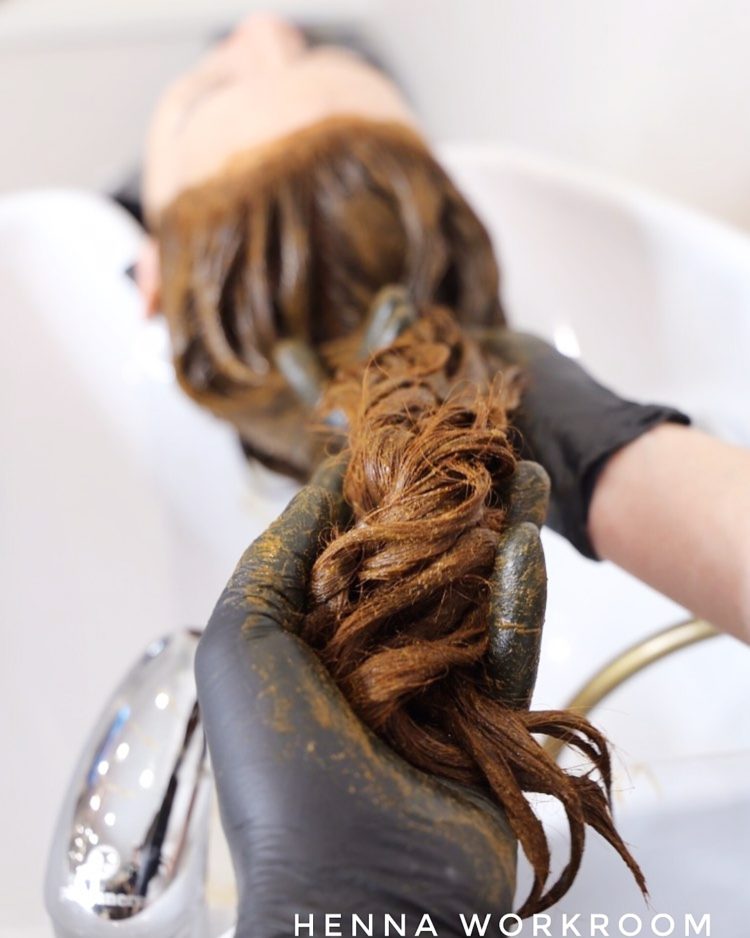
How to dilute and prepare henna for coloring?
It is required to prepare a solution by filling the powder with the required amount of water, put it to heat in a water bath for 7-10 minutes. The mixture is then ready for use.
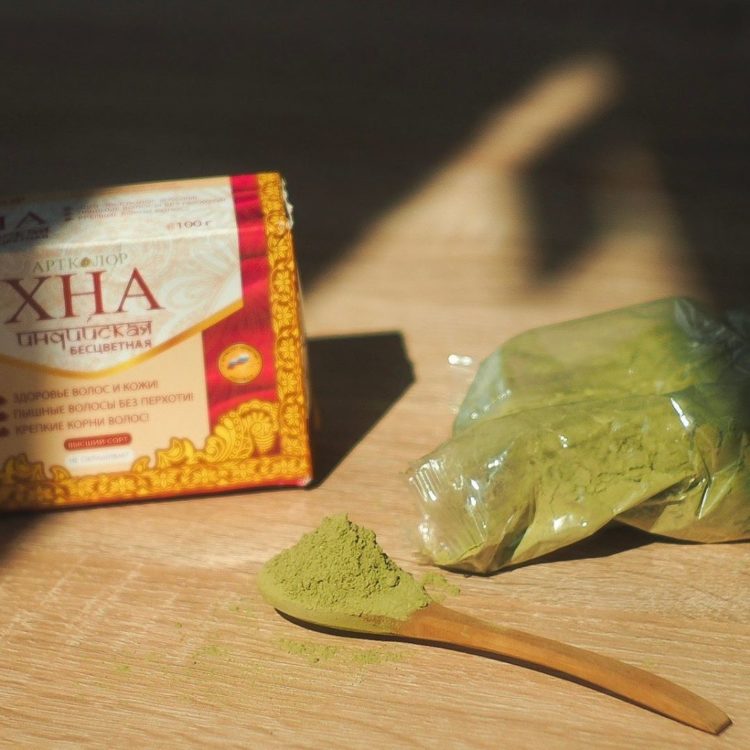
Recipes for dyeing hair with henna - what components to add when brewing it
In its pure form, henna (Iranian) gives a reddish color. Below are the ingredients that can change the shades obtained after painting. If you add to henna:
- Hibiscus tea, cloves, beet juice - you get a cherry, burgundy color;
- Turmeric, onion peel or chamomile decoction give the hair a golden and light red hue;
- Basma is not used alone without henna, since it can dye hair blue or green, are used only in pairs. When mixed in different proportions these two components, the color will give a color from chocolate to black. The more the percentage of basma is diluted, the darker the color of the curls will be;
- Carrot juice, a small amount of iodine, turmeric give curls a red, copper tint.
Henna hair coloring tips and tricks
- If you want a brighter color, add citric acid / lemon juice / vinegar to the broth;
- In order to protect curls from drying out - brew the powder with kefir;
- In order not to make the curls split, brittle and dry, use egg yolks, vegetable oils when brewing;
- Be sure to rinse off a mixture with balm and masks;
- For a healing effect keep colorless henna on your hair for 2 hours;
If your hair is too dark, there is a risk that you may not be able to get a red color. In such a situation, you can resort to hydrogen peroxide, honey or chamomile decoction.
Hydrogen peroxide brightens curls the most radically. To preserve the health and beauty of your hair, take a 3% composition. Pour into a spray bottle and spray over your curls. Leave the solution overnight. In the morning you will notice the lightening effect. Hydrogen peroxide must be washed off with shampoo and balm, which is better to hold for a longer time.
How to wash off henna?
It is required to wash off the coloring composition with warm running water. It is not necessary to use shampoo, you can use a hair conditioner.
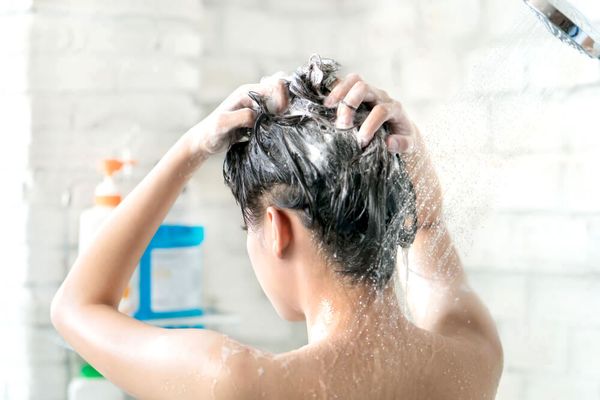
Henna-dyed hair care
Henna-dyed hair requires special care. As described above, this natural dye is capable of drying curls. Therefore, it is necessary to choose the right care that is aimed at nourishing and moisturizing the hair. In addition, care products should be from the line "for colored hair". The best shampoo is mild, sulfate-free. It will not dry out and wash out color quickly.
Without the use of nourishing masks and balm, the hair runs the risk of turning into an overdried "broom".
Be sure to have indelible care in your arsenal: spray, oil for the ends, serum. This will help keep the colored curls beautiful and healthy.
The result of henna staining: photo BEFORE and AFTER
The result of dyeing hair with henna may vary. It all depends on the base color of the curls.
In the photo below you can see the result of dyeing previously dyed hair with henna. The girl turned out to be bright red, but her hair does not emit light, as it was previously damaged.

The following photo demonstrates how great the quality of hair can be. if you paint intact hair with henna.

Dyeing for dark hair
Dark-haired girls will not be able to significantly change their hair color with henna. Coloring can only give the strands a more intense shade.
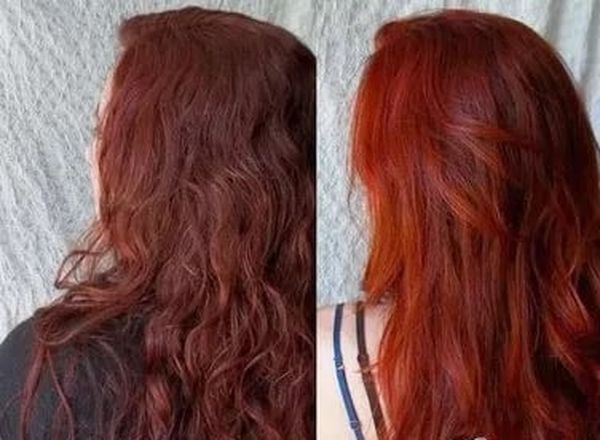

Hair dyeing
Using the powder on light brown hair gives the hair a palette of reddish shades, such as:
- bronze;
- copper;
- caramel;
- rich burgundy;
- chestnut;
- coffee;
- Brown.

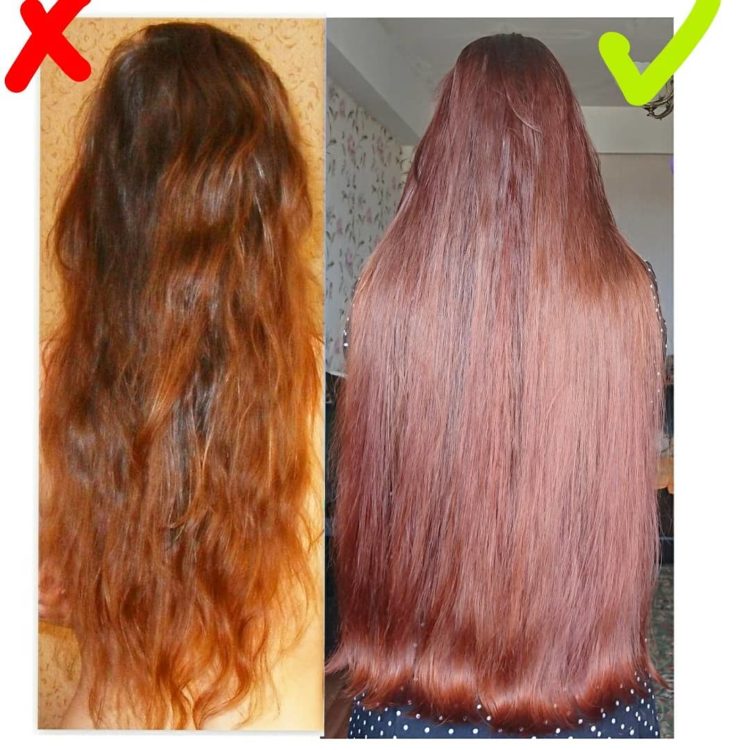
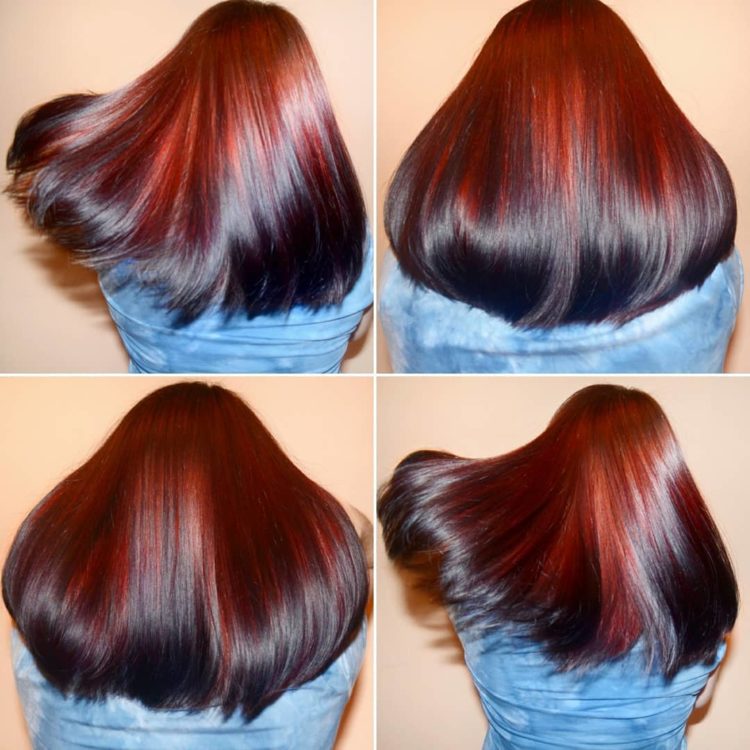
It all depends on the chosen composition.
Henna dyeing for blond hair
Henna dyeing blond hair will give maximum results. The hair will turn out to be very bright, saturated.
This option is suitable for girls who are used to being in the spotlight, like to turn all eyes in their direction.
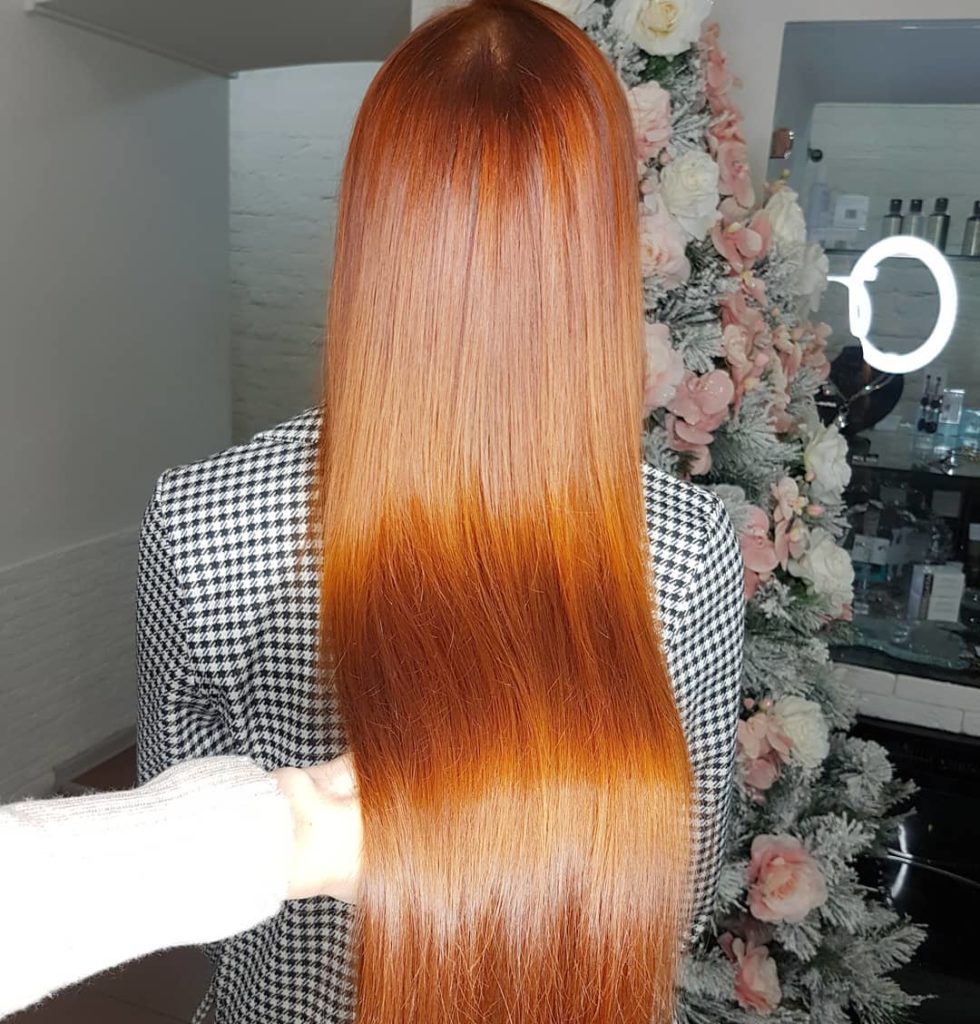

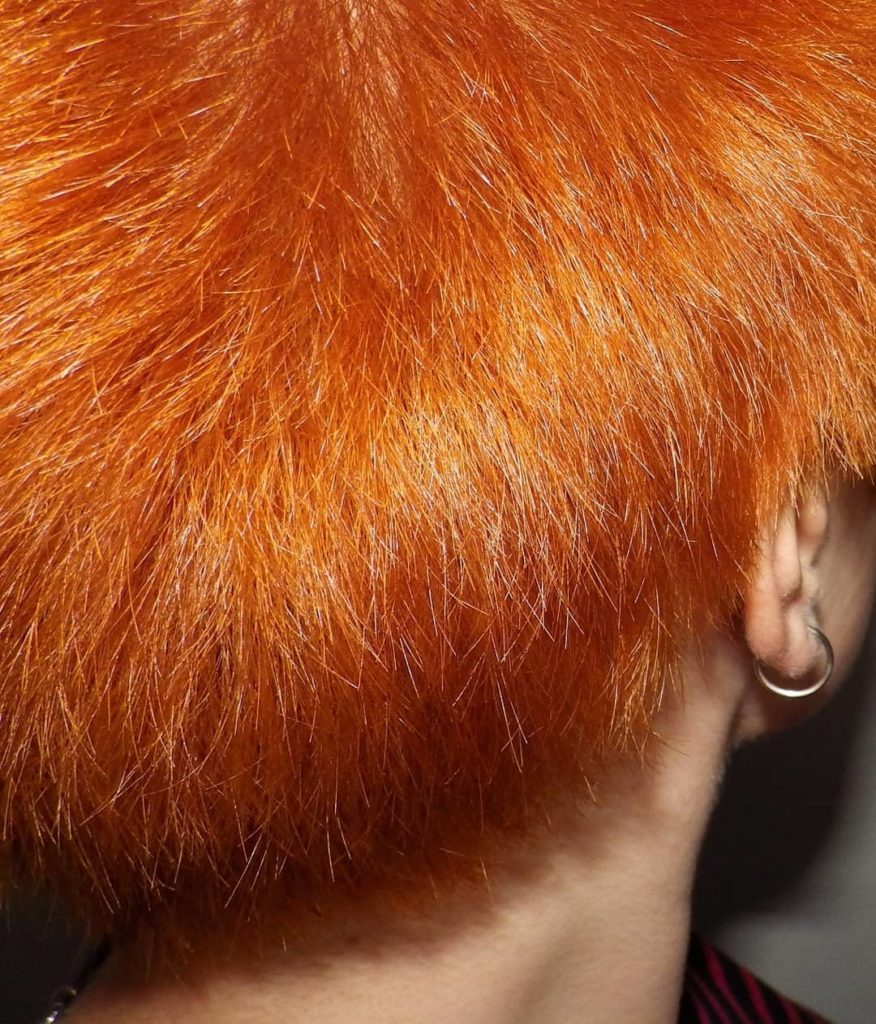

What does henna consist of?
It contains green chlorophyll and lawson (hennotanic acid) with a yellowish-red hue. The product also contains substances such as:
- resin;
- fatty components;
- vitamins C and K;
- polysaccharides;
- organic acids;
- essential oils.
The maximum amount of coloring components is present in the lower leaves of henna, and they accumulate during flowering.
Henna coloring is carried out due to the accumulation of pigment in the upper layers of the hair. The dye does not get into their structure, but it gives the hair color for a long time. In terms of color stability, henna can be compared to chemicals.
After dyeing with this product, the hair may take on a reddish-red or reddish-brown tone. An orange tint may well be added. If you mix this substance with other ingredients, you can get a wider palette of colors.
Types of henna for hair
The main henna producers are the countries of the Arab world and the East, where thornless lawsonia grows. The leaves of this plant contain natural pigment. Each manufacturer has its own colored henna for hair.
Iranian
When used alone, Iranian henna gives a bright red color, in mixtures with various additives it transforms hair from warm caramel to rich chocolate.

Sudanese
Manufactured in Saudi Arabia. Supplied on sale in the form of a green powder. Gives a long-lasting copper tint. Chestnut and reddish colors are obtained if mixed with basma.
With alternate staining - first Sudanese henna, then Basma - get an ashy tone.

Indian
Indian henna is often used as a remedy to prevent hair loss and dandruff. It has five shades: golden, burgundy, brown, black and mahogany.
To vary the shades, it is mixed with herbal additives in the form of wine, coffee, beet juice, tea.

Colorless
For the production of colorless henna, not the leaves are used, but the stems of the plant, as well as Ziziphus prickly and Cassia dull-leaved, in which there is no coloring matter.
The main purpose is hair treatment. Eliminates dandruff, restores shine, causes accelerated growth, reduces the appearance of oily hair.

White
White henna cannot be classified as a completely natural product. In its creation, chemical ingredients of an aggressive nature are used that act on the hair as artificial brighteners.

White henna is harmless and inexpensive. A snow-white shade can be obtained after several staining procedures. There is no healing effect.
How to achieve the desired shade?
All henna is made from the same plant, but it is grown in different places, and this affects the content of the coloring pigment in it. For example, Egyptian henna has a soft copper hue, but Indian or Yemeni is brighter, closer to red.
Everyone knows that henna cannot be of all colors of the rainbow, like permanent hair dyes. That is why, to achieve the desired effect, henna can be mixed in various proportions with other components.
- Lawsonia gives brown or black in combination with basma or indigofer dye... The result depends on the percentage of ingredients.
- Also, in order to shade the curls with brown, you can use a mixture of henna and walnut leaves (his green shell), coffee or acacia catechu... Acacia produces browns and dark browns.
- There are options for blonde hair lovers too. For example, you can use saffron or chamomile. They give a golden hue. However, the interaction with chamomile is not very effective, the color is unstable and quickly washed out.
- Beets or cocoa can give a beautiful red tint, which will emphasize individuality. Strengthening the same shade is promoted madder and hibiscus.
- A rich golden yellow hue is obtained thanks to mixtures of rhubarb or turmeric stalks.
- Shikakai when interacting with henna, it gives the hair darker shades.
We select the color
For a long time using natural raw materials for hair coloring, many recipes have been developed that help to get the shade that a lady needs. Let's find out what and how to breed henna.
Henna and Basma
A mixture of henna and basma is the most popular option, which gives different coloring properties in terms of color.
By doing hair coloring with henna and basma, you can get such shades as bronze (2: 1), dark chestnut (1: 1), black (1: 2).
The more basma, the darker the resulting color.

Ginger
For the manifestation of different red shades, take 2 parts of henna and 1 part of basma. By changing the duration of the dye exposure on the hair, the following result is obtained: 30 minutes - light redhead, 1 hour - fiery red, 4 hours - dark red.
Red
To make the hair shine red, cocoa powder or a decoction of madder root is added to henna. In the first case, 3 tablespoons of cocoa are taken for 1 part of henna, diluted with hot water.In the second option, 2 tablespoons of chopped madder root should be poured with water and a decoction is made, then henna should be added to it.
Chestnut
By adding 2 tablespoons of chamomile infusion to the herbal remedy, you will get a warm chestnut color. A more intense tone will give a mixture of henna with basma in a 1: 3 ratio.
Watch the appearance of the pigment during staining to stop the procedure when the tone suits you.
In brown
A mixture of 1 part henna and 4 parts basma will help to achieve a good brown color. Blondes will have to repeat the procedure for their hair to take on a dark brown tone.

Blond
The composition of the mixture, which gives light brown color, includes: henna (4 tablespoons), 1 yolk (you need to beat), cocoa (2 tablespoons), cedar oil (4 tablespoons), peach oil (1 spoon), a glass of kefir, 1 ampoule of vitamin E ...
Measure all ingredients with tablespoons. We apply the product without heating, apply it to wet strands, let it stand for 1–1.5 hours.
Golden
For this effect, turmeric can be used as additives in a 1: 1 ratio or chamomile infusion (for half a glass of boiling water, 1 tablespoon of chamomile).
Chocolate
Chocolate hair will become if you add a decoction of walnut leaves to the main raw material. For 1 glass of water, take 1 tablespoon of leaves, boil for 15 minutes, pour into the powder.

10 important things to consider when dyeing henna
Before you decide to dive into the world of natural hair coloring, check out the important points that affect the result.
1. Make sure the henna you are using is natural
Only Lawsonia should be in the lineup. A manufacturer who has nothing to hide always indicates its international designation in Latin Lawsōnia inērmis
2. Henna is not washed off. Never at all.
You cannot wash its reddish shade, discolor to its former color. Do not try to do this, because it is IMPOSSIBLE to return YOUR shade to henna-dyed hair. Just take it for granted from the beginning. You can cut and grow your hair to your previous color, but you cannot rinse the henna off the hair dyed with it.
True, there is one trick that you can use if for some reason you are not happy with the shade. About this in the next paragraph and in the tips below.
3. Henna can be muted.
That is, to make the red shade less flashy. Basma can help you with this because
4. Henna cannot be combined with chemical paints. Neither before nor after staining.
The result of the combination is not predictable, but always distressing. Henna can only be combined with natural herbal dyes. Cut off the chemically dyed and permanent-treated ends before applying the henna.
5. The result of dyeing with henna will be predictable and of high quality only if you dye natural hair.
- A reddish-brown tint can be obtained by mixing 2 parts of henna and 1 part of basma
- You get a dark brown shade if you mix 1 part henna and 2 parts basma
- A deep brown color is obtained by mixing 1 part henna and 4 parts basma.
In a palette of brown shades, freshly ground coffee can be used instead of basma. True, its coloring properties are much weaker, but it also acts as a conditioner.
Basma in its pure form can be used if you have naturally black hair, or according to the principle of separate dyeing, as, for example, the Chinese do. They first withstand clean henna on their hair and receive high-quality care, immediately after that they apply pure basma and get a high-quality dark color.
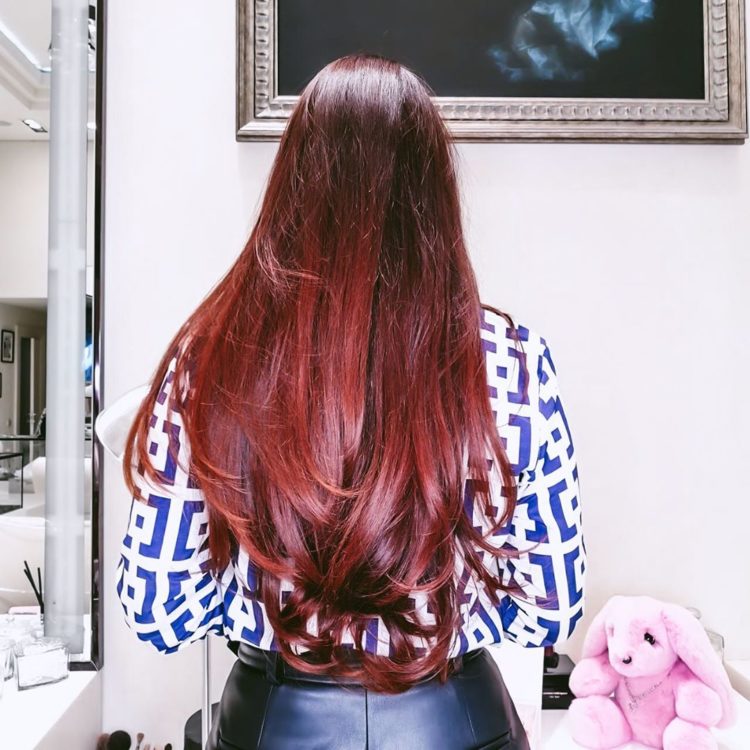
6. The lighter your own hair, the brighter the result will be.
Therefore, it is better not for natural blondes to use natural henna. To strengthen hair without dyeing, there is the so-called "colorless henna".
7. Colorless henna is not just one Lavsonia.
- In Russia, a plant is considered colorless henna. Ziziphus prickly (Ziziphus Spina-Christi L.)
- Outside of Russia, this is the name of the plant. Cassia blunt-leaved (Cassia obtusifolia L)
There is a difference between them. Ziziphus is much cheaper and more affordable. You can buy it wherever Iranian henna and basma are sold. And you can meet Cassia only in professional salons in our country and abroad. The difference in properties is about the same.
8. Dilute henna in a non-metallic container.
It is best to use glass and porcelain dishes, and stir with a brush for application, as is done in hairdressing salons.
9. Apply henna only to clean hair.
Chemical dyes are always applied to unwashed hair, and vegetable natural dyes only to clean, literally freshly washed hair.
Therefore, you can easily understand how natural hair dye is (even if its name contains the word "henna"), according to the manufacturer's recommendation, on which hair to apply it.
10. You should know the properties that the hair will acquire after dyeing with henna.
- RIGIDITY - the hair becomes substantially harder and thicker. This means that they will become more obedient, but will not be crumbly as before.
- SHINE - to a large extent, the shine is enhanced and will not disappear if you regularly use henna. You will notice this in your own flash photography.
- COLOR - your hair will never be ashy with gray hair. It will definitely be a juicy shade ranging from fiery to brown, depending on what additives you add to the mixture.
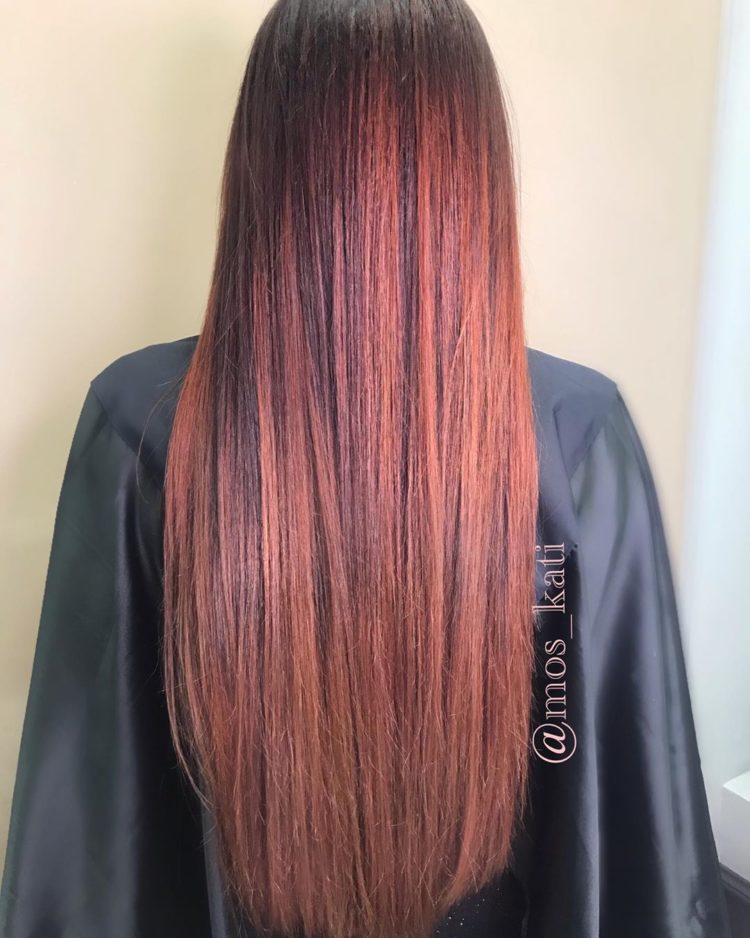
How to remove henna from hair
Oil mask
We heat the olive or burdock oil, cover all the strands with it, cover the head with a bag and a towel. We stand for 3-4 hours, then thoroughly rinse the hair with shampoo.
Alcohol mask
The procedure requires 70% alcohol. It needs to be applied to the hair and left for 5 minutes, after which the alcohol is washed off, and instead of it, oil is distributed through the hair, which eliminates unwanted pigment. To enhance the impact. The head needs to be wrapped in a towel and warmed up with a hairdryer. After half an hour, the mask can be washed off with a shampoo for oily hair.
Sour cream.
The product must be sour. It must be distributed through the hair, put on a hat and leave for an hour. It will not completely get rid of the color, but it will tone it down.
Soap.
Laundry soap combined with oil will help wash out unwanted shades. But you will need to be patient, because you will need to wash it off within a month.
Kefir and yeast.
The method will take several days. It is necessary to mix kefir and yeast until smooth, which should then be applied to the hair. The mixture is washed off the head after at least 2 hours.
Vinegar.
The vinegar must be mixed with water. Approximate proportion: 3 tablespoons of vinegar to 5 liters of water. After that, the hair must be kept in the solution for 10 minutes and washed off with regular shampoo. In order not to damage the hair, a balm is used.
The benefits of henna for hair
According to trichologists, henna is one of the safest hair dyes and also a source of many substances useful for hair. Replacing ordinary paint with it, you can get several advantages at once:
- Strengthening the bulbs. If you are worried about hair loss, monthly henna dyeing or a course of masks with its colorless variety will certainly help;
- Decrease in sebum secretion. Owners of oily hair have to wash it every day. Henna will dry out the scalp thanks to the tannins in its composition. Over time, the work of the sebaceous glands is normalized;
- Dandruff disappearance. Already after the first dyeing, you will notice that the amount of untidy white flakes at the hair roots has noticeably decreased. After several procedures, the skin will be completely cleansed;
- Reducing fragility. Henna contains vitamins C, K, B, essential oil, and tannins filling the hair shaft make it stronger. The strands will become more rigid, but they will stop breaking. A thin protective film formed by the dye on the hair will prevent splitting of the ends and protect against aggressive external factors;
- Volume. Due to the same film, the hairs become thicker, which means they become more voluminous.This effect is cumulative, that is, it increases with each procedure, provided they are regular: an increase in volume can reach 30%;
- Preservation of hair structure. Henna coloring pigments do not destroy hair shafts, do not exfoliate scales;
- Henna is practically hypoallergenic. It is suitable for use during pregnancy, teens and even children can treat hair with it. Cases of individual intolerance are extremely rare.
When used correctly, natural henna will not only help you transform, but will also become an affordable home care procedure.
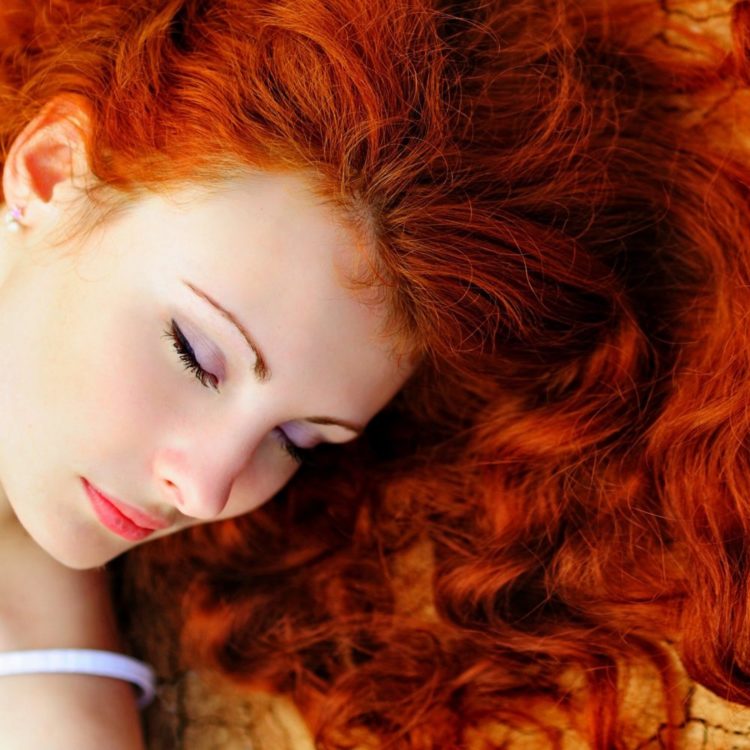
Potential harm
Not all trichologists are unanimous about the use of henna for hair. The controversy has emerged following a recent scientific study of the plant Lawsonia inermis in some regions for genotoxicity. Although the results concluded that there was a link between henna painting of mehendi and the incidence of leukemia in women in Central Asia, this cast a shadow over other uses of henna.
Excessive enthusiasm for henna masks can really harm your hair:
- Dry. The opposite effect of drying - if the hair is initially prone to brittleness, losing moisture, it will generally look like tough straw, it will lose elasticity;
- Straighten. An interesting effect is encountered by ladies who dyed their hair with henna after a perm - the curls are partially straightened, which looks at least sloppy;
- Not suitable for blondes. Having decided to radically change the image by dyeing the light strands in deep red, give preference to other dyes, otherwise you will get an orange hue. Of course, treatment with a colorless species is not taboo;
- Mismatch in tone. The most common harm from using henna is spoiled mood. The color can go into a green or gray shade, it is difficult to fix it. If you have previously dyed your hair, wait at least 2 months before applying henna. Better yet, fully grow the natural color;
- Henna is difficult to remove from hair. You can't just paint over a boring tone, you will also have to wait 2-3 months.
Before trying coloring with a natural dye, it is better to consult a trichologist - the doctor will give his opinion on the condition of the hair and the advisability of treatment. In any case, it is recommended to purchase only a quality product from a specialized store.
Using colorless henna
If the purpose of using henna for hair is not a color change, but a treatment, then you do not need to insist henna for a long time. It is enough to fill it with hot liquid, leave for an hour. Then soak about the same amount of time on the hair, scalp.
What can be added to henna masks:
- herbal decoctions;
- oils;
- milk products;
- natural honey;
- egg yolks.
The general rules for using henna masks that are beneficial for hair do not change: the products must be applied before shampooing. If the hair has styling products or is too dirty and oily, then the rule changes. First you need to wash your hair, then apply henna, then just rinse the mask without shampoo, but with balm.
During the aging of the mixture on the hair, the head is always covered with polyethylene, you can additionally insulate it with a hat or towel, the percentage of penetration of nutrients into the rod will be higher.

Recently, I only use henna for coloring. My hair fell out a lot, was dull and faded. And after painting with henna they become silky and soft. The gray hair is painted over remarkably, the painting is enough for a month. I constantly make masks from oils, I can even add burdock or castor oil to the finished henna.
After the first birth, there was no question of any hair coloring, the hair fell out in bundles. Henna turned out to be the only salvation for me. She began to make masks with henna, with the addition of burdock oil 2 times a week. After 2 months, the hair returned to normal, stopped breaking and acquired softness and shine.
If I use henna with kefir, then I let the mixture stand in a warm place for 8-10 hours. Then the effect is much better than if you use it right away - the color is brighter. Kefir also prevents hair from becoming dry.
I know about the benefits of henna firsthand. After using it, the hair really becomes stronger and less shedding. But since I like to paint in different colors, and in the salon they refuse to carry out staining after applying henna, I stopped using it.
I have been using henna for 10 years. I brew ground strong coffee, boil it for 5 minutes, and add it to henna until the consistency of sour cream, keep it warm for 2 hours, the result is beautifully paints over the gray hair, the hair is thick, silky and shiny, and the color does not have a pronounced reddishness, closer to chocolate. You can experiment, someone breeds strong tea leaves, someone red wine. Yes, and I also want to say, never add lemon juice to henna, I myself know it dries your hair a little, and with lemon it is a disaster for your hair !!!
I add ground coffee to henna with basma.
I also buy vegetable paints, but usually the color of chocolate. I take any company and henna and tonic and tint shampoo. I rarely dye because the hair has almost retained its color so far, but has become dull. with henna groats I try not to take .. maddening when rinsing. I take creamy.
Thank you very much for the treasure trove of valuable information !!! I was just thinking of dyeing it with henna and thinking about which one to buy more expensive and cheaper. And then I see your most interesting article !!!
I didn't know that henna is also so beautiful) Thanks for the article
Thank you so much for the helpful article. I just wanted to try colorless henna hair treatment. Your article came in handy.
A number of familiar reenactors bought basma specifically for dyeing fabrics in a gray-gray color (some blue tint). As far as I know, indigoferra basma and normal fabric dye are produced slightly differently, although the plant is the same. But, probably, the usual pharmacy basma is not of the highest quality.
Thanks a lot for the article !!!!! I have been thinking for a long time to go buy hair dye, but now I will definitely go to my favorite henna. While studying at the institute, I dyed my hair only with it !!!!!
Thank you, very useful information! I love henna, especially kefir.
I buy henna at the pharmacy. Triuga Herbal Ayurvedic. I've been painting only this for two years. Hair has become much better.
I love henna Once upon a time I experimented with various additives, which only shades and effects did not get! Then I found the best recipe for myself, and for almost ten years I have been using it regularly. So what about the "harm from long-term regular use" - for sure, the machinations of manufacturers of chemical paints. My experience confirms this.
Hello! Good article, thank you. I have been painting my hair with henna for almost 30 years - no problems with hair. If dandruff suddenly appears, I add a few drops of tea tree oil. I always paint at night. And I buy in Auchan in ordinary white and red bags, the cheapest. Color always Excellent. Several times henna was brought from Tajikistan (Afghani) - it is completely different, the hair after it is much softer. But once they brought a strange one - it practically did not stain at all and we refused it. By the way, chemical paints also apply to henna. I especially like highlighting and then paint with henna once.
Thanks for the article, as always, I read it with pleasure!
I remember grandmothers who dyed their hair with henna and went all red, they probably did something wrong)))
Good evening everyone. I read the article with interest and especially the comments. I decided to talk about my experience with henna. since the problem of gray hair for me got very good. acutely - 50%, and chemical paints need to be painted after 15 days, I decided to completely switch to henna with basma. I experimented for a long time. Sellers advised different recipes - add cognac to henna and bring to a boil, very good. beautiful colors, right. But the roots are still gray, and the whiskey is bright red. I added coffee and cocoa, which just did not do, the gray hair remained.
The combination with basma also did not give a result - the roots are gray, and the whiskey is bright red. I decided to dye my hair with henna first, keep it for about an hour, wash it off, dry my hair, then apply basma. And you know - it worked: gray hair is not visible at all, red whiskey turned brown. At last. the only drawback is the long process, half a day is needed. But I agree. )))
Very informative! Henna is the most wonderful thing, confirmation of this is my mummy, who dyed her hair below the waist all her life with a mixture of henna and basma, brewed on strong black Indian tea. Luxurious deep brown shade, strong, shiny hair - the object of envy and pride, of course ... In recent years, my mother cut her hair short and stopped dyeing with henna due to the fact that there was a lot of gray hair, and now I dye her hair with “sparing” chemical dyes of lighter colors , calm shades. Sister, on the contrary, change to henna - and the effect of health improvement is obvious.
Let me throw in your patch :)))
I paint with henna…. I don’t remember exactly, well, let it be 5 years old. A lot of gray hair - hereditary early gray hair, alas…. I tried various herbal supplements, stopped at this option.
Henna coloring and henna colorless are brewed with a strong decoction of black tea + chamomile. I take the cheapest tea, you need more of it, a couple of tablespoons. Chamomile - if in bags, then two. I insist the broth, then I heat it additionally in the microwave. Sometimes I add cinnamon, just a little, it burns if you overdo it.
The roots grow quickly - by the way, because of henna :))) - I paint once every two weeks. I do not hold it for long, half an hour. The color is not straight red-red, but muted autumn, natural. I like….
I don't use basma - at all.